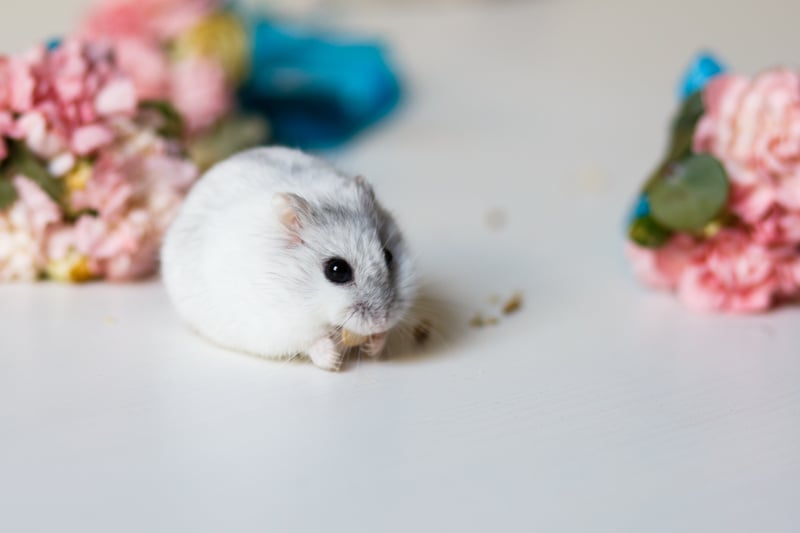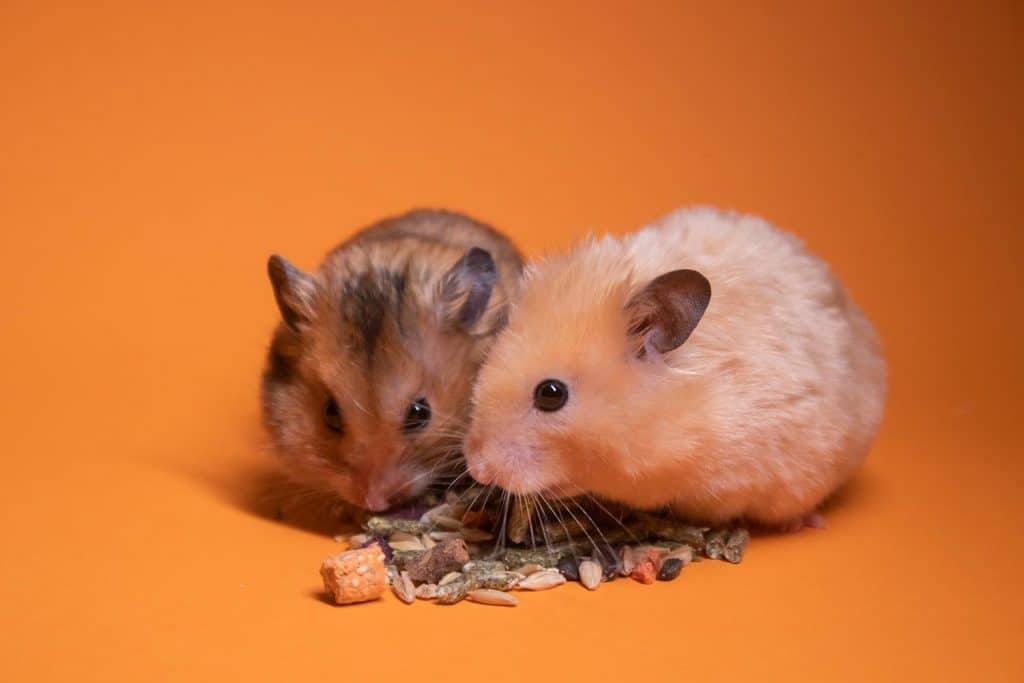You may wonder if your hamster experiences a menstrual cycle or period like you do. After all, aren’t they also mammals?
A thorough investigation has been conducted by our team in order to offer you more information on this topic.
Hamsters do not have menstrual cycles. Rather, they go through an estrus period. Seven times a year, this will happen. In place of blood, hamsters produce a whitish discharge.
The most likely scenario is that you’ve previously witnessed an estrus discharge and have always been interested as to what it actually is.
If you’d want to learn more about your female hamster, keep reading. Here, we’ll discuss the reproductive cycle of female hamsters and how they become pregnant.
Do Female Hamsters Get Periods?
No, they don’t do it like other female mammals. The female hamster does lay eggs that must be fertilized by the male, but if the eggs haven’t been fertilized, there is no bloody discharge.
Sometimes, there might be one single drop of blood, but that’s it.
Instead, the female will give off a white substance at the end of her “period.” This happens every four days, and the female is only able to breed during the night for 12 hours.
She gives off a strong smell that night to attract the male hamster. This is what it means for a hamster to be “in heat.”
This begins when the hamster is sexually mature, which is around 8 weeks, and goes on until she dies or gets too old.
What is the estrus cycle?
When they reach sexual maturity, all-female hamsters go through the estrus cycle.
In contrast to a person’s menstrual cycle, which happens once a month, a hamster’s estrus cycle happens seven times a month. You can expect your hamster to start estrus every four days.
If you look at your hamster closely, you can tell when she is in her estrus cycle. They will have a little bit of white discharge come out of their vagina.
The estrus cycle lasts for about 12 hours when it does happen. It will start at night when your hamster is awake and moving around the most.
When your hamster’s estrus cycle starts, it’s basically telling you that it’s ready to mate. This is pretty much what “going into heat” means for a hamster.
If there are male hamsters around, they could get together and have babies.
Later in life, female hamsters will no longer have an estrus cycle, just like women do when they reach menopause and stop having periods. Because they will be too old to have children.
The estrus cycle is important for breeders because it’s the only time that female hamsters will respond to males. If your female hamster isn’t in heat, she might be aggressive toward other males.
If you’re not a professional breeder of hamsters, you don’t have to worry too much about the estrus cycle.
Even though it is known that female hamsters like the smell of male hamsters more when they are in estrus, there shouldn’t be any major changes in behavior.
Do Female Hamsters Bleed During Estrus?
In estrus, hamsters do not generally bleed, but they do expel fluids in their excrement. In most cases, it is a thick, white discharge.
When a female hamster is nearing the conclusion of her estrus cycle, her feces may contain a small amount of blood. On the third day of estrus, this is a common occurrence.
Taking your hamster to the vet for an examination if you find that she is bleeding profusely from her private region could indicate internal bleeding. Internal bleeding is life-threatening and requires immediate attention.
When your hamster is in estrus, it is usual to see white discharge from her genital area. After mating, your hamster is likely to generate a white, gluey secretion for the first five days afterward.
After mating, your hamster’s stomach will begin to bulge and get larger in around ten days. After mating, her pups (baby hamsters) will come in 15 to 22 days.
It is typical for your hamster to have a bloody discharge before giving birth to its puppies.
How Can You Tell Your Hamster is in Heat?

There are a few things you can look for to tell if your hamster is in heat.
Smell
Female hamsters during estrus can smell a bit musky or pungent. If you notice your hamster smells a little more than usual, then she may be in heat.
Discharge
This mucus or discharge comes from the hamster’s private area when she is in heat.
This is typically a thick, paste-like substance that is a bright white hue. It’s perfectly natural and there’s no reason to be alarmed.
Your hamster’s private area may also appear red or bloated. This, too, is not a problem to be concerned with.
Behavior
A few female hamsters are more agitated when they are in heat. In the heat, it’s normal for your pet to be more restless or nippy than usual.
She could possibly be more active than usual. The reason for this behavior is that she is actively searching for a mate (and is unaware that she will not find one in her cage!).
Your hamster’s tail is an excellent indicator of whether or not she is in heat. Lifting her tail after she has frozen and remained motionless is a good idea.
They show this type of behavior when you massage them near their tail since this is what male hamsters generally do before mating
To tell the male that she’s ready for sex, a female hamster acts this way.
When/what age to let the female hamster mate?
When it’s best and worst to allow the female hamster to reproduce, there are rules to follow. This is due to the fact that hamsters are still growing during pregnancy, and it’s not an easy one.
To avoid difficulties, it is best to avoid pregnancy in hamsters older than 15 weeks. Ten to fifteen weeks is the sweet spot.
Between weeks 10 and 14, the male hamster is thought to be at its optimum for mate selection, whereas the female hamster can begin mating as early as week 10.
When you present the female to the male for sex, there are a few things you need to keep in mind. Despite the fact that the female is eager to mate, she may not always accept the male in question.
Even though it varies from hamster to hamster, the mating ritual can be quite severe for the hamsters involved.
Tumbling and fighting are certain to occur. To find out if he’s worth her eggs, she’ll test him out. Usually, he is.
Occasionally, the male is too weak or the female is too threatening, and this can cause conflict.
As a result, the current male character must be replaced with a new one, ideally, one who is stronger than her.
At night, when the female wakes up with a white and thin secretion, this needs to be done. She should be in the middle of her cycle by now, on her second day.
He has just one night to get her pregnant, and it’s only 12 hours long.
Has Your Hamster had Contact with a Male?
Pregnancies in hamsters are very short. Depending on the type of hamster you have, they might have babies less than 3 weeks after mating.
If your hamster was with a male more than 30 days ago, it’s safe to say that your pet is not pregnant.
Take a look at how long it takes different kinds of hamsters to give birth:
- Dwarf (Roborovski) Hamster: 22 days
- Golden (Syrian) Hamster: 16-18 days
- Dwarf Winter White (Russian) Hamster: 21 days
- Campbell Russian Hamster: 18-20 days
As you can see, hamsters don’t have babies for a long time.
When Are Female Hamsters Sexually Mature?

When a female hamster reaches a particular age, she doesn’t go into heat. As soon as they’ve reached this point in their development, pregnancy is possible.
Female hamsters reach sexual maturity earlier than you might assume given their short lifespans. Your female hamster will be ready to mate within the first six to seven weeks of her life.
In certain animals, sexual maturity may occur earlier or later than in others. Syrian hamsters are sexually mature at 45 days, or about seven weeks.
Campbell’s dwarf hamsters, on the other hand, are susceptible to a wide range of environmental factors.
Sexual maturity occurs more swiftly in a female hamster that has been raised by males.
In an all-female environment, it may take a woman longer to become sexually mature than in an all-male environment.
A hamster should get pregnant within the first 10 weeks of its life.
Because they’re in peak health, they’re able to conceive at this time. A woman can conceive and give birth to a healthy baby if she is 15 weeks pregnant, but don’t push it.
How Do You Know Your Hamster Is Pregnant?
If you bought a female hamster that had been in the same cage as a male hamster, it’s likely that the two have mated. You don’t have to guess if your hamster is pregnant. There is a way to find out for sure.
You’ll want to look in the vagina for a “coital plug.” It’s not too soft and is a creamy white color. Since male hamster sperm is part of the copulatory plug, if you see one, it’s likely that your female hamster is now pregnant.
If you also see a white discharge from your hamster that is thick and lasts for more than five days, this means that the pregnancy was successful.
The hamster’s belly will start to look bigger in about 10 days, or sometimes 18 days. From there, the length of her pregnancy could be anywhere between 16 and 22 days.
The length of pregnancy will depend on the species.
When your female hamster is about to give birth is another time when you might see blood.
Again, if this is just one or two drops, there’s nothing to worry about. If it’s more than that, you should take your pet to the vet.
When a hamster has babies, there may be six or eight of them. Her behavior can change just before she gives birth. She might have too much energy or even a little bit of anger.
Hamster Discharge Outside of the Reproductive Cycle
A disorder known as pyometra, which is an infection of the uterus, can on occasion cause your hamster to experience vaginal discharge. Pyometra is a medical term for this condition.
In this particular scenario, the discharge could have a yellowish hue and smell very terrible.
If you observe this behavior in your hamster, you should consult a veterinarian to receive more treatment and advice.
Conclusion
Traditional menstruation cycles do not apply to hamsters.
Their estrus cycle signals that they are ready for mating with a male, rather than going through the process of mating themselves. Your female hamster’s discharge will notify you when she’s in heat.
The best thing you can do for your female hamster throughout her estrus cycle is to keep her away from men.
An exhausting and demanding job that demands a lot of expertise and responsibility is breeding hamsters. Keeping baby hamsters costs a lot of money as well.
If you’re looking for a new hamster, leave it to the professionals and consider adoption. You’ll be pleased you did!






